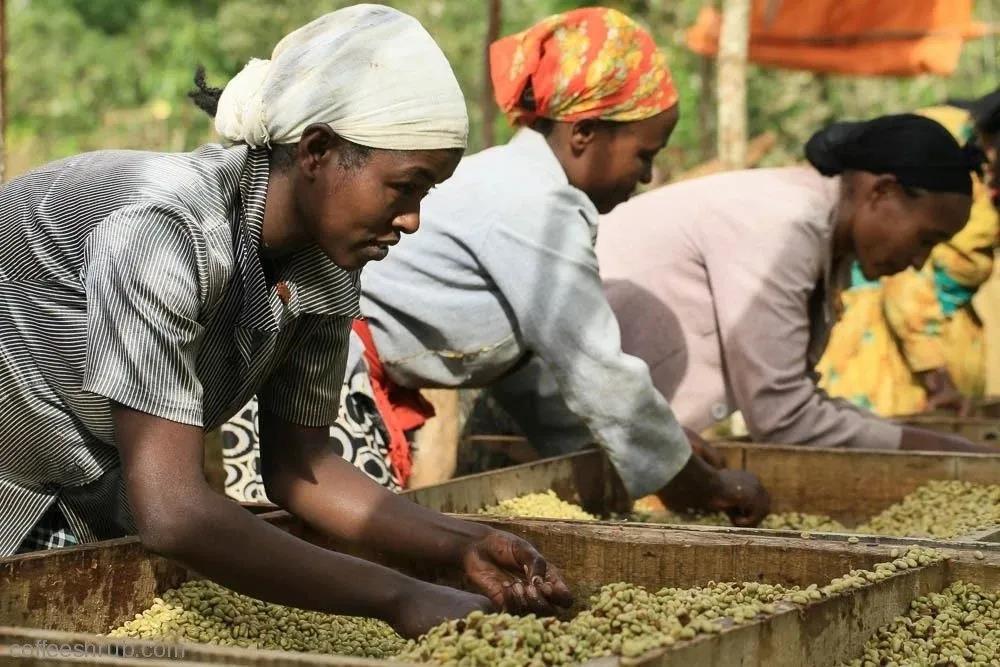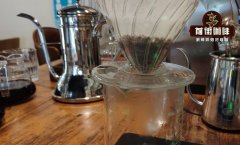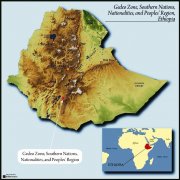What is a coffee cooperative? Brewing parameters of coffee beans in Ethiopia Yega Xuefei Coffee Cooperative

Professional coffee knowledge exchange more coffee bean information please follow the coffee workshop (Wechat official account cafe_style)
The Yegashafi producing area in Ethiopia includes many cooperatives, large and small, and coffee cooperatives are non-profit organizations that all participate voluntarily in order to make it easier for members to have access to resources when producing or serving coffee. Although the flavor of coffee produced by many cooperatives may be more or less the same, the coffee produced by each cooperative has a different story behind it. This time Qianjie is going to come to talk about the Guoding Cooperative of Yejasuefi.
Yejia Xuefei
Yirgacheffee
Yejasuefi has always been one of the most important coffee producing areas in Ethiopia. It once belonged to the Sidamo coffee producing area, and later became an independent coffee producing area because of its unique flavor. It can be said that Yejashafi is not only a name of coffee producing area, but also a term for the description of specific coffee flavor.

Yejia Xuefei coffee producing area is a high altitude coffee producing area, which is about 2000 meters above sea level. There are more than 40 cooperatives in the Yejashafi coffee producing area, which mainly manage coffee cultivation in a family business model. There are also many well-known micro-producing areas under the Yega Sheffield Coffee area, such as Cochel, Fog Valley, Godibe and so on. These micro-producing areas have excellent cooperatives, and the Yega Xuefei coffee beans have their own unique flavor characteristics.
Guoding Dingding Cooperative
Banko Gotiti
The Godding Cooperative, located in the Waka producing area at the southeast end of Yega Sheffield, was originally part of the Waka Cooperative under the YCFCU of the Yega Sheffield Alliance. Later, with the pursuit of the traceability of raw coffee beans, the "single producing area" was excavated by coffee hunters all over the world.

In 2012, Guodingding, which has about 300 farmers, independently set up the "Guodingding Cooperative". Guodingding Village was the first independent village area, and many small farmers were also members of the Waka Cooperative, so the technology of producing coffee was not to mention. The Guodingding Cooperative is known as the last piece of pure land of Yega Xuefei, so it is also a traditional way to use raw bean treatment (water washing and sun treatment).
Coffee bean variety
Heirloom
Yejia Xuefei coffee variety is a local native species, small granule species, the appearance is more round, the bean body is very small, mostly between 14 and 15 orders. However, Qianjie Coffee found that in the COE competition held by Ethiopia this year, Ethiopia also began to divide the coffee varieties, of which the 13th place was the Kurme variety from the Yega Sheffield region. KURUME is actually a common non-coffee plant in southern Ethiopia, which is rich in yield and small in fruit, and has the same characteristics as a local coffee, so the local coffee farmers call the coffee with this characteristic KURUME. The coffee bean variety of Qianjie Coffee Fruit Ding Cooperative is a local native variety.
Coffee bean treatment
Washed
Qianjie Coffee Fruit Tintin Cooperative Coffee beans are washed. After the peel / pulp of the berry is removed by a planer, it is placed in the fermentation tank for 18-36 hours until the pectin layer decomposes (depending on the local temperature and humidity), and then the shelled beans will be washed through the washing channel for 30-60 minutes.

At this time, through the channel design combined with water erosion, the beans with low specific gravity and poor quality can be removed, and then the high quality beans with shells can be placed in an African scaffolding to dry for about 14 days. after drying, the beans will be stored in the warehouse of the treatment plant, and the shell beans will be transported to Dry Mill (dry treatment plant) to be shelled before export, and through a series of complicated screening processes, such as foreign body removal, silver peeling and polishing, gravity screening, color selection and so on. Finally, it is bagged and exported.

Producing area: Yega Xuefei Gedeo Zone producing area
Altitude: 1900-2300m
Variety: original species (Heirloom)
Treatment: washing
Suggestion on coffee baking in Qianjie
The front street baker considers that the bean is mainly represented by the acidity of the fruit, which is more suitable for the shallow baking method, which will highlight the clean taste, bright acidity and obvious taste.

Using the Yang family 800N, the amount of beans: 480g: furnace temperature to 175C ℃ into the pot, throttle open 3, firepower is 120,140℃, when the firepower is unchanged, the throttle opens to 4; at this time the bean table turns yellow, the smell of grass completely disappears, enters the dehydration stage, when the firepower drops to 100176 ℃, the firepower drops to 80, and the throttle remains unchanged. The smell of toast obviously changes to the smell of coffee, which can be defined as a prelude to an explosion. At this time, it is necessary to listen carefully to the sound of the explosion point. When the sound of the explosion starts, adjust the throttle to 5 (the tuning power should be very careful, not so small as to be so small that there is no burst sound). After an explosion, the development of 1 cup 39th 30 ", 193.5 ℃ into the pot.
Coffee cup test report on Qianjie
Qianjie Coffee will be tested within 8-24 hours after the sample beans are roasted. Baristas in front of the street generally use ceramic bowls with a capacity of 200ml, which will be marked with 150ml and 200ml marks. According to SCAA standards, the TDS of water is about 150ppm, TDs is too low will easily cause excessive extraction, too high will affect the taste and easy to lack of extraction, the water temperature used in the cup test is 94 °. The pass rate of 20 # standard screen (0.85 mm) controlled by grinding degree is 70% Mel 75%. Ratio: 11 grams of coffee powder and 200 milliliters of hot water, that is, 1VR 18.18, so that the concentration of the extract is exactly within the range of 1.15% Murray 1.35% gold cup, and the soaking time is 4 minutes.

The dry aroma of washed fruit shows fresh aromas of passion fruit, citrus and berries. Wet aroma is the acidity of citrus, berries, imported citrus, sweet berries, almonds, tea, with honey sweetness in the finish. Alcohol thickness is low, acidity is bright, clean and refreshing.
Experience of brewing coffee in Qianjie
Filter cup: V60 # 01
Water temperature: 90-91 degrees
Powder content: 15g
Ratio of powder to water: 1:15
Degree of grinding: BG6m/ fine sugar size (20 sieve bowl sieve powder to 80%)

Qianjie cooking technique: the first section is filled with 30 grams of water for 30 seconds, then 95 grams (about 125 grams shown by the electronic scale) is injected, and the injection is completed in about 1 minute. When the water level drops to 2 grams in the powder layer, the remaining 100 grams (about 225 grams shown by the electronic scale) are injected in about 1 minute and 35 seconds. 2: 10 "trickling is completed, remove the filter cup and complete the extraction.
Brewing flavor: there are citrus and black tea in the entrance, cream, caramel and almond aftertaste with a clean and sweet taste with the change of temperature.
For more boutique coffee beans, please add private Qianjie coffee on Wechat. WeChat account: kaixinguoguo0925
Important Notice :
前街咖啡 FrontStreet Coffee has moved to new addredd:
FrontStreet Coffee Address: 315,Donghua East Road,GuangZhou
Tel:020 38364473
- Prev

Roasting adjustment and extraction adjustment of raw coffee beans what are the effects of soft and hard water on the extraction of coffee
98% of coffee is water, while 94-95% of a cup of espresso is water. So, in the whole coffee equation, water is an extremely important ingredient. In many cases, it is always ignored, so does the roasting and extraction of coffee also need to be adjusted in different drinking environments? How does water quality affect the taste of coffee? Water is
- Next

Characteristics of brewing flavor of washed coffee beans in the micro-producing area of Yega Xuefei coffee
Professional coffee knowledge exchange more information about coffee beans Please follow the coffee workshop (Wechat official account cafe_style) loyal fans of Yegashafi Coffee must have heard of Kochel, the famous micro-producing area of Ethiopia. Kochere is located in the quintessence of the whole generalized Yejashefi region. In the production area of ECX, Cochel (Cochel) belongs to an independent production.
Related
- Beginners will see the "Coffee pull flower" guide!
- What is the difference between ice blog purified milk and ordinary milk coffee?
- Why is the Philippines the largest producer of crops in Liberia?
- For coffee extraction, should the fine powder be retained?
- How does extracted espresso fill pressed powder? How much strength does it take to press the powder?
- How to make jasmine cold extract coffee? Is the jasmine + latte good?
- Will this little toy really make the coffee taste better? How does Lily Drip affect coffee extraction?
- Will the action of slapping the filter cup also affect coffee extraction?
- What's the difference between powder-to-water ratio and powder-to-liquid ratio?
- What is the Ethiopian local species? What does it have to do with Heirloom native species?

